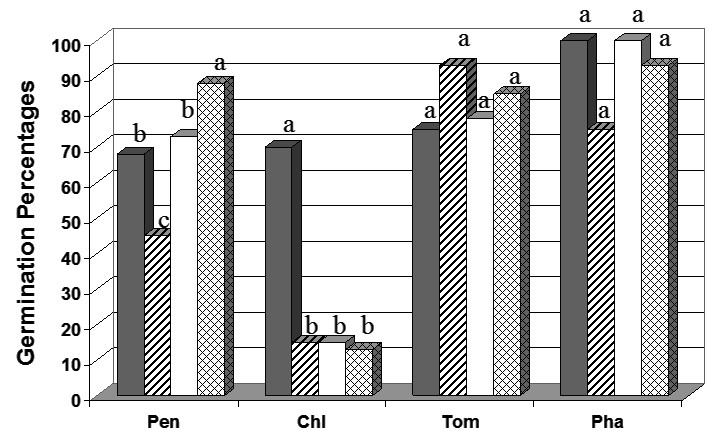ศักยภาพทางอัลลีโลพาทีในดินของใบพืชสกุล Cinnamomum บางชนิด
Main Article Content
Abstract
Chalermchai Wongwattana and Teerarat Chamchaiyaporn
รับบทความ: 5 สิงหาคม 2557; ยอมรับตีพิมพ์: 24 พฤศจิกายน 2557
บทคัดย่อ
ทดสอบศักยภาพทางอัลลีโลพาทีในดินของใบพืชสกุล Cinnamomum จำนวน 4 ชนิดในสภาพห้องปฏิบัติการ ได้แก่ กระวาน (Cinnamomum parthenoxylon Meissn.) การบูร (C. camphora Nees ex Eberm.) อบเชยญวน (C. loureirii Nees.) และอบเชยเทศ (C. zeylanicum Nees.) และใช้พืชทดสอบ 4 ชนิด ได้แก่ หญ้าขจรจบดอกเล็ก (Pennisetum polystachyon (L.) Schult) หญ้ารังนก (Chloris barbata Sw.) มะเขือเทศ (Lycopersicon esculentum Mill.) และถั่วผี (Phaseolus lathyroides L.) โดยนำใบแห้งที่บดละเอียดมาคลุกกับดินขุยไผ่แห้งที่เอาเศษเจือปนออกหมดแล้ว ในอัตราส่วนใบแห้งต่อดินเท่ากับ 1:10 1:20 และ 1:40 โดยน้ำหนัก และใช้ดินที่ไม่คลุกใบพืชเป็นตัวเปรียบเทียบ ให้น้ำทางจานรองจนอิ่มตัว ปลูกเมล็ดพืชทดสอบแต่ละชนิดลงในดินผสมนั้น 20 เมล็ดต่อกระถางที่ความลึก 0.5 เซนติเมตร ตรวจนับความงอกของเมล็ดทุกวันและวัดความยาวลำต้นและรากของต้นกล้าที่ 7 วันหลังเพาะ ใบพืชสกุล Cinnamomum ทั้ง 4 ชนิดที่คลุกดินในอัตราส่วนต่าง ๆ มีผลยับยั้งการงอกและการเจริญ เติบโตของต้นกล้าพืชทดสอบที่ระดับต่าง ๆ กัน โดยความงอกของเมล็ดได้รับผลกระทบมากที่สุดและความยาวลำต้นได้รับผลกระทบมากกว่าราก ในกลุ่มของพืชทดสอบ พบว่า หญ้ารังนกมีความอ่อนแอต่อใบพืชที่คลุกกับดินมากที่สุด ในใบพืชสกุล Cinnamomum ทั้ง 4 ชนิดที่ทดสอบใบการบูรคลุกดินให้ผลการยับยั้งการงอกและการเจริญของต้นกล้าสูงสุด โดยสามารถยับยั้งการงอกของเมล็ดหญ้ารังนกอย่างสมบูรณ์และลดการเจริญของพืชทดสอบอื่น ๆ 50-100% และใบอบเชยญวนคลุกดินมีผลการยับยั้งต่ำที่สุดในการทดลองนี้ ความแตกต่างของศักยภาพทางอัลลีโลพาทีในดินของพืชสกุลนี้ทั้ง 4 ชนิดอาจเกิดจากความแตกต่างทางอัลลีโลพาทีภายในใบพืชแต่ละชนิดเอง หรือเกิดจากความแตกต่างในการเปลี่ยนแปลงของสารอัลลีโลพาทีจากพืชแต่ละชนิดหลังจากที่ปลด-ปล่อยลงในดิน ผลการทดลองนี้ชี้ให้เห็นถึงศักยภาพของใบการบูรในการนำไปประยุกต์ใช้ในการจัดการวัชพืช
คำสำคัญ: อัลลีโลพาที ดิน Cinnamomum ความงอกของเมล็ด การเจริญของต้นกล้า
Abstract
Study on allelopathic potential of Cinnamomum spp. leaves in soil was conducted in laboratory at Faculty of Science, Srinakharinwirot University. Dried ground leaves of 4 Cinnamomum spp. (Cinnamomum parthenoxylon Meissn., C. camphora Nees ex Eberm., C. loureirii Nees. and C. zeylanicum Nees) were mixed with soil at various leaf: soil ratios (w/w), and 20 seeds of each test plant were grown in separated pot. Seed germinations were checked daily and seedling growths were determined at 7 days after planting. Soil mixed with Cinnamomum spp. leaves affected seed germination and seedling growth of test plants at various levels. Seed germination was more sensitive to Cinnamomum spp. leaves than seedling growth and shoot growth was found to be more sensitive than root growth. Among test plants used in this study, Chloris was the most susceptible plant to all Cinnamomum spp. leaves. C. camphora leaf mixed with soil showed the highest inhibitory effects on seed germination and seedling growths. In the present study, it completely inhibited Chloris seed germination and reduced growth of the other test plant species for 50% to 100%, whereas C. loureirii leaf showed the lowest effects. The differences in allelopathic effects in soil of these 4 Cinnamomum leaves may be due to the differences in their own allelopathic activity or from the different ability in changing the allelochemicals from each species after released into soil. These results indicated the high potential of C. camphora to be applied in agricultural weed management.
Keywords: Allelopathy, Cinnamomum, soil, Seed germination, Seedling growth
Downloads
Article Details

This work is licensed under a Creative Commons Attribution-NonCommercial 4.0 International License.
References
Dabney, S. M., Schreiber, J. D., Rothrock, C. S., and Johnson, J. R. (1996). Cover crop affect sorghum seedling growth. Agronomy Journal 88: 961-970.
Ells, J. E., and Mcsay, A. E. (1991). Allelopathic effects of alfalfa plant residues on emergence and growth of cucumber seedling. Horticultural Science 26(4): 368-370.
Kong, C. H., Wang, P., Gu, Y., Xu, X. H., and Wang, M. L. (2008). Fate and Impact on Microorganisms of Rice Allelochemicals in Paddy Soil. Journal of Agricultural and Food Chemistry 56: 5043-5049.
Premasthira, C., and Zungsonthiporn, S. (1995). Allelopathic substance contianed in Gooseweed (Sphenoclea Zeylanica Gaerth). Proceedings of the 15th Asian-Pacific Weed Science Society Conference (pp. 311-313). Japan: Tsukuba University.
Shilling, D. G., Dusky, J. A., Mossler, M. A., and Bewick, T. A. (1992). Allelopathic potential of celery residue on lettuce. Journal of the American Society for Horticultural Science 117: 308-312.
Tworkoski, T. (2002). Herbicide effects of essential oils. Weed Science 50: 425-431.
Vidal, R. A., Hickman M. V., and Bauman, T. T. (1998). Phenolics adsorption to soil reduces their allelochemical activity. Pesquisa Agropecuaria Gaucha 4(2): 125-129.
Viles, A. L., and Reese, R. N. (1996). Allelopathic potential of Echinacea angustiforia D.C. Environmental and Experimental Botany 36: 39-43.
Weidenhamer, J. D., and Romeo, J. T. (2004). Allelo-chemicals of Polygonella myriophylla: Chemistry and soil degradation. Journal of Chemical Ecology 30(5): 1067-1082.
Wongwattana, C., and Chamchaiyaporn, T. (2004). Effect of Cinnamomum leaves-water extract on grassy plants seed germination. Proceedings of the 30th Congress on Science and Technology of Thailand (B0139). Bangkok: Impact Exhibition and Convention Center, Muang Thong Thani.
Zhu, X., Zhang, J., and Ma, K. (2011). Soil biota reduce allelopathic effects of the invasive Eupatorium adenophorum. PLoS ONE 6(9): e25393.
